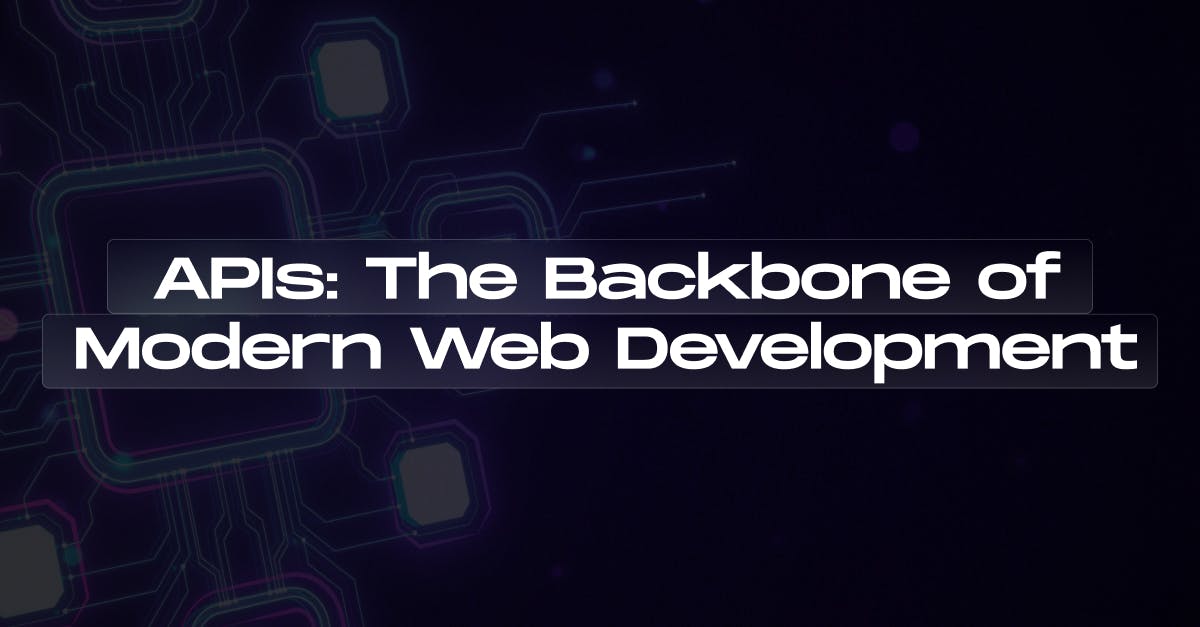April 30, 2025
What Are APIs? Why They Matter in Modern Web Development

Nusrat Sarmin

Ever wondered how your weather app pulls real-time forecasts from satellites? Or how a "Sign in with Google" button just works—instantly?
There’s a powerful force at work behind all that convenience: APIs.
From streaming platforms to banking apps, APIs are the gears turning behind your favorite digital experiences. They let apps “talk” to each other, send data, and work together smoothly—even if they were built by entirely different teams.
So what are APIs exactly? And why do they matter so much in web development today? Let’s break it down in simple terms.
“In 2024, the significance of APIs has grown remarkably. According to Postman's 2024 State of the API Report, their user base expanded from 25 million in 2023 to over 35 million in 2024. Additionally, Cloudflare's 2024 API Security and Management Report reveals that 57% of all internet traffic now consists of API requests. These statistics underscore the central role APIs play in today's digital ecosystem.”
What Is an API?
API stands for Application Programming Interface. Simply put, it’s a set of rules and protocols that allow one piece of software to communicate with another.
It’s like a waiter in a restaurant—taking your order to the kitchen and bringing the food back. Whether it’s between frontend and backend systems, or third-party tools and your website, APIs bridge the gap.
In technical terms, an API defines how developers can request and send data between systems. They expose specific endpoints that allow you to send, retrieve, update, or delete data—all without revealing how the underlying system works.
The Role of APIs in Modern Web Development
Web development has evolved beyond just writing HTML, CSS, and JavaScript. Today, modern web is about integration, automation, and performance, and APIs make all of that possible. Their roles have evolved significantly with the growth of web frameworks like React, Vue, and Next.js, which rely heavily on APIs to pull in content dynamically.
Here’s how APIs contribute to modern web development:
1. Seamless Integration Across Services:
APIs allow developers to connect websites and apps with powerful external services—like payment systems, messaging tools, or location data. This helps add complex features quickly without building them from scratch, saving time and effort.
Example: A food delivery app can use Mapbox for navigation, Firebase for logins, and SendGrid for emails—all via APIs.
2. Connecting Frontend and Backend:
Modern web apps increasingly adopt headless and decoupled architectures. In this setup, the frontend communicates with the backend purely through APIs. This not only speeds up performance but also lets content teams and developers work in parallel without bottlenecks. Ideal for headless eCommerce and JAMstack setups.
3. Microservices and Modular Development:
APIs enable microservices and modular systems. You can build individual services (like user authentication, notifications, or payment processing) that communicate through APIs.
4. Third-Party Integration:
APIs enable web apps to embed ready-made services instead of building them from scratch. From adding payment gateways like PayPal to tools like Google Maps, they simplify integration and speed up development.
5. Mobile & Multi-Platform Support:
APIs make it possible to deliver the same features and data across websites, mobile apps, and even smart devices. Developers can build multiple frontends while keeping the backend logic consistent and centralized. This leads to cost-effective, scalable cross-platform development.
6. Real-Time Capabilities:
APIs support real-time features like live chat, instant notifications, and live data updates. This creates a more interactive and responsive experience for users, important for industries like finance and communication.
7. AI, Automation, and Data Integration:
APIs make it easy to add AI tools, automate repetitive tasks, and connect different data systems. From OpenAI to Zapier, APIs make automation and AI integration easy. Want to analyze customer feedback using sentiment analysis or automate form submissions? There’s an API for that.
What’s more, the role of APIs in modern web development extends far beyond the points mentioned above. Countless other applications—like voice assistants, wearable tech, AR/VR experiences, and personalized content delivery—rely heavily on APIs. In short, if the web is evolving, APIs are the engine driving it forward.
Benefits of APIs in Modern Web Development
The advantages of integrating APIs into your development process are both strategic and practical:
- Faster Development: Use existing solutions instead of building everything from scratch.
- Scalability: Easily add new features or services without rebuilding the entire app.
- Improved User Experience: Provide real-time data, personalization, and functionality from other platforms.
- Better Developer Experience: Simplify workflows, reduce complexity, and focus on building core features.
- Innovation Potential: Experiment with AI, automation, or analytics APIs to evolve your offering.
- Cost-Effectiveness: Reduces infrastructure needs and long-term development overhead.
Real-World Examples of API Usage Across Industries
- E-Commerce: Shopify’s API enables developers to create custom themes, apps, and integrations, empowering businesses to build unique, tailored online stores that meet their specific needs.
- Social Media: Instagram’s Graph API allows businesses to schedule posts, fetch analytics, and seamlessly integrate social media features into third-party applications, streamlining content management.
- Finance: Stripe’s API powers secure, customizable payment processing for millions of businesses worldwide, ensuring safer, more flexible online transactions.
- Healthcare: APIs that follow HL7 or FHIR standards enable the secure exchange of patient data across healthcare systems, ensuring timely and accurate access to medical records.
- Maps & Location Services: Google Maps API lets apps like Uber and Airbnb embed interactive maps with live data for locations, routes, and availability, enhancing user navigation and experience.
- Real-Time Syncing: Firebase API powers real-time database syncing for messaging apps and live dashboards, ensuring instant updates and better user interaction.
- Weather Data: Weather APIs provide real-time forecasts, temperatures, and alerts on websites and mobile apps, helping users stay informed about weather conditions relevant to their activities.
- User Authentication: OAuth APIs, like "Login with Google" or "Login with Facebook," simplify and secure user authentication, offering a seamless sign-in process across multiple platforms.
The Future of Web Development with APIs
The future is API-first. More companies are shifting to API-first strategies, building with flexibility, speed, and scalability in mind.
What’s driving this shift?
- GraphQL for precise, efficient data delivery.
- API marketplaces like RapidAPI for instant plug-and-play integrations.
- AI-powered APIs from OpenAI and Google Cloud for smarter, adaptive apps.
- No-code/low-code website platforms that empower non-developers to build.
- Secure access via API gateways, OAuth, and governance tools.
- Developer-first tooling like Swagger, Postman, and observability stacks.
- API versioning to maintain stability as platforms evolve.
Conclusion: The Modern Web Runs on APIs
APIs are no longer optional—they’re essential. They streamline development, power real-time experiences, and connect services in ways users rarely see but constantly rely on. From single-page apps to robust enterprise platforms, mastering APIs is key to building future-ready web solutions.
Need help integrating powerful APIs into your next project? Let StaticMania handle the backend magic—so you can focus on growth.
Everything You Need to Know About APIs in Web Development
An API (Application Programming Interface) allows different software systems to communicate and share data with each other. In web development, APIs are used to connect front-end and back-end systems or integrate third-party services.
APIs enable developers to build scalable, flexible, and modular applications. They allow the reuse of existing functionalities like payment gateways, social media logins, or cloud storage without rebuilding from scratch.
APIs send requests from one system to another and return responses. For example, a website might use an API to fetch user data from a database or display live weather data from a third-party service.
APIs are mainly used for:
- Accessing third-party services like payment gateways (Stripe), maps (Google Maps), or login systems (OAuth).
- Connecting front-end applications to back-end servers.
- Enabling data sharing between platforms.
- Automating workflows and triggering actions between apps.
Common types include:
- REST APIs – popular and easy to use with HTTP methods.
- GraphQL APIs – flexible, query-based APIs for precise data fetching.
- SOAP APIs – older, XML-based, and used in enterprise systems.
- Webhooks – event-driven APIs that push updates in real time.
APIs reduce development time by providing ready-to-use services. Developers can integrate features like maps, payment processing, or authentication quickly without building them from scratch.
Yes. APIs allow both web and mobile apps to access the same backend, ensuring consistent functionality and faster cross-platform development.
APIs can be secure if properly implemented. Common practices include using API keys, OAuth tokens, HTTPS, and rate limiting to prevent abuse.
An API is a set of rules for communication between systems, while a plugin is a software add-on that adds features to an existing platform or tool. APIs offer more flexibility and control.
To use an API, first choose one and read its documentation. Then, get an API key if needed, make a request using tools like fetch or Axios, and use the returned data in your app. Always handle errors and follow security best practices.

